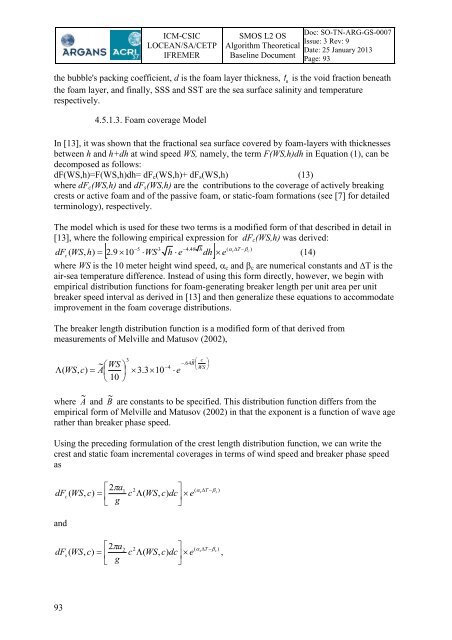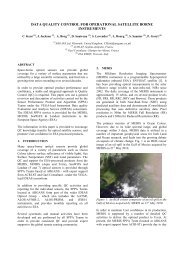SMOS L2 OS ATBD - ARGANS
SMOS L2 OS ATBD - ARGANS
SMOS L2 OS ATBD - ARGANS
Create successful ePaper yourself
Turn your PDF publications into a flip-book with our unique Google optimized e-Paper software.
93<br />
ICM-CSIC<br />
LOCEAN/SA/CETP<br />
IFREMER<br />
<strong>SM<strong>OS</strong></strong> <strong>L2</strong> <strong>OS</strong><br />
Algorithm Theoretical<br />
Baseline Document<br />
Doc: SO-TN-ARG-GS-0007<br />
Issue: 3 Rev: 9<br />
Date: 25 January 2013<br />
Page: 93<br />
the bubble's packing coefficient, d is the foam layer thickness, f a is the void fraction beneath<br />
the foam layer, and finally, SSS and SST are the sea surface salinity and temperature<br />
respectively.<br />
4.5.1.3. Foam coverage Model<br />
In [13], it was shown that the fractional sea surface covered by foam-layers with thicknesses<br />
between h and h+dh at wind speed WS, namely, the term F(WS,h)dh in Equation (1), can be<br />
decomposed as follows:<br />
dF(WS,h)=F(WS,h)dh= dFc(WS,h)+ dFs(WS,h) (13)<br />
where dFc(WS,h) and dFs(WS,h) are the contributions to the coverage of actively breaking<br />
crests or active foam and of the passive foam, or static-foam formations (see [7] for detailed<br />
terminology), respectively.<br />
The model which is used for these two terms is a modified form of that described in detail in<br />
[13], where the following empirical expression for dFc(WS,h) was derived:<br />
5<br />
3 4.<br />
48 h ( cT c<br />
)<br />
2. 9 10<br />
WS<br />
h e dh<br />
e<br />
dF ( WS,<br />
h)<br />
(14)<br />
c<br />
where WS is the 10 meter height wind speed, c and c are numerical constants and is the<br />
air-sea temperature difference. Instead of using this form directly, however, we begin with<br />
empirical distribution functions for foam-generating breaker length per unit area per unit<br />
breaker speed interval as derived in [13] and then generalize these equations to accommodate<br />
improvement in the foam coverage distributions.<br />
The breaker length distribution function is a modified form of that derived from<br />
measurements of Melville and Matusov (2002),<br />
~ WS<br />
<br />
(<br />
WS,<br />
c)<br />
A<br />
3.<br />
310<br />
10 <br />
3<br />
4 <br />
~ c <br />
.<br />
64B<br />
<br />
WS <br />
e<br />
where A ~ and B ~ are constants to be specified. This distribution function differs from the<br />
empirical form of Melville and Matusov (2002) in that the exponent is a function of wave age<br />
rather than breaker phase speed.<br />
Using the preceding formulation of the crest length distribution function, we can write the<br />
crest and static foam incremental coverages in terms of wind speed and breaker phase speed<br />
as<br />
2<br />
dFc<br />
( WS,<br />
c)<br />
<br />
g<br />
and<br />
<br />
<br />
<br />
1 2<br />
( s s )<br />
( , )<br />
T<br />
a <br />
c WS c dc e<br />
2a<br />
2 2 ( sT<br />
s<br />
)<br />
dFs<br />
( WS,<br />
c)<br />
c (<br />
WS,<br />
c)<br />
dc e<br />
g<br />
,



